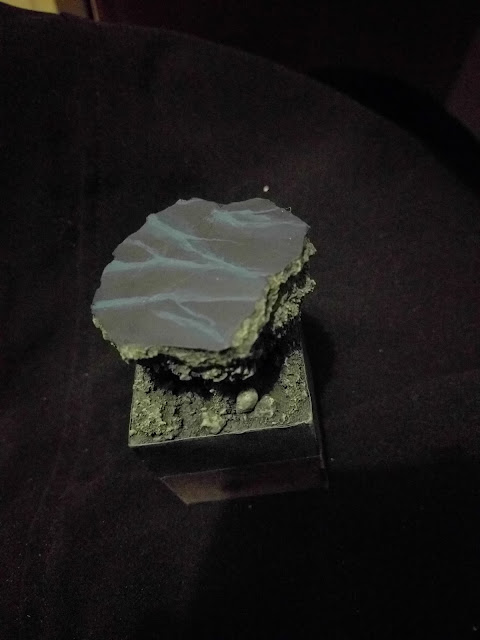Back for part 2 of my James Wappel inspired basing experiment. Last Week (shameless link) we constructed a base out of sculpey, cork, sand, stones and passion. This week comes the painting. First up here is the primed base as we left it.
As I mentioned last week James has written many articles on this technique over the years but I feel this ones is the most useful. Link
The rocks I drybrushed with a variety of grey tones, and even some flesh tones in places.
I started the marble with a very thinned down layer of doombull brown and added a little blue to add some variation, just wet mixed on the base. What is this for? Well...I must admit I'm not entirely sure. I guess it provides a varied base for the marble. You might notice I added a little skull to the base after priming.
We start with a couple of think coats of our base colours. I've used a mix of black and Dark Prussian Blue from Vallejo Model Colour. This is the colour I used in the shadows of the miniature so it helps tie it together.
Starting on the marble. I took quite a large brush (I used some cheapo synthetic brushes I have that I use for paint mixing. I mixed more Dark Prussian Blue and very loosely sketched some veins in, using a damp brush to help blend in places.
From here it's just lightening the colour and finer veins, following the pattern I started with. I lightened the blue towards Alaitoc blue (a blue I used for the model too)
Keep going! White added, even finer veins.
Last thing I did was go back in with a darker mix (almost black) and added a few darker sections.
There was a final step but I forgot to take a photo so it's mixed in with the next section. I glazed over the whole marble area with a very thinned layer of grey(VERY thinned, you don't want it too thick because it will ruin it!) what this does is help give it a much more natural depth.
Now comes the tough bit, the emblem on the top. Always slightly terrifying painting over a surface you've spent time on! Not really easy to correct mistakes so you have to be very careful. I sketched the design I wanted on paper a few times for practice before picking up a brush. I used a pencil to mark out a few key points to help guide me. Then with a thinned paint (Celestra Grey from GW) I started with the eye in the centre of the design.
And onwards, taking it one shape at a time. Anyone know what it is? Answers next week :D
Black lining will help, I used a very dark grey for this, not pure black. Veeeery carefully I went round the entire design. Can also see I used some blending on the grey to add some variation. I also used some of the grey to help thin a few bits of black that I'd made too think.
Cracks! Remember I sculpted some cracks in the sculpey? Time to add some dark blue/black paint to the cracks.
Then some light grey to help define the cracks.
Final step is the washes on the rocks and the little skull I added. I used a few Secret Weapon Washes (Soft Body Black, Drying Blood, Algae), Army Painter Strong Tone and GW Drakenhoff Nightshade. All mixed on the base with a damp brush. The skull itself was painted with GW Karak Stone, Black and Ivory to shade and light. Note: I've filtered out the model until next week's showcase! Looking at the photos I still need to add some gloss to the marble for that shine factor. The model needs a few finishing touches too.

















Wow! That is pretty incredible stuff, I got his shaded base coat video tutorial and my test model turned out horrible. His technique is backwards from everything standard painting has taught me so it was a rough outing, it's cool to see someone do well from his tutorials!
ReplyDeleteThanks Ryan,.yeah it was nice to push myself to try something different. Freehands are something I really need to practice on to improve.
DeleteWow great job, looking forward to seeing it with a model on! :)
ReplyDeleteditto! Hopefully I can find some time over the Christmas period to finish it.
DeleteI like the helpful info you provide in your articles. Good luck for the next.
ReplyDeleteIncredible plenty of awesome tips you've shown to us. Great post.
ReplyDeleteThanks for sharing your thoughts. I trulу apρreciate youг efforts
ReplyDeleteI truly appreciate this post. You have made my day! Thankyou so much
ReplyDelete